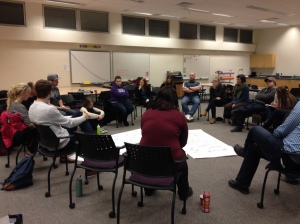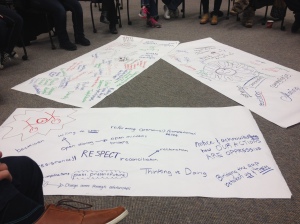Last night, I had the unbelievable opportunity to help facilitated the first STARS Regina event after our club was formed in the Fall 2014 semester. We decided that not everyone is as comfortable talking about social justice issues as we are, so we held a sharing circle to raise awareness of social justice within the community and help our peers develop the confidence to talk about these issues. Two amazing professors within the education faculty, Mike Cappello and Sean Lessard. The circle was mainly centered around teaching, but we had two guests who weren’t in the education faculty and their input and ideas were more than appreciated because they helped us take these issues outside of the classroom and into the broader community. By now you may be wondering about the title of this blog post, so I’ll explain that to you now.
Sean opened up the circle with a story about truly listening to one another in order to gain perspective on stories. While preparing for the event, he reached out to one of his mentors and heard a long-winded story about how he met the Dalai Lama and was fixated on what type of shoes this incredibly religious man wore, and the story ended with him finding out that the Dalai Lama wore converse. What was the meaning behind this story? Sean didn’t know, so he asked what this had to do with the sharing circle we held and his mentor clarified for him. It doesn’t matter where we come from, what we do, or even who we know – if we really want to have a conversation with someone, no matter how different their beliefs and values may be from ours, we can always find common ground. We can always find ways to open up conversations about our differences, but we must start with a similarity, even if it is something as trivial as the shoes on our feet.
After we had all introduced ourselves and explained how we got to the sharing circle, we broke off into small groups to brainstorm and answer some questions about social justice in the broader community. The first prompt seemed simple, but inspired some very deep thinking. What does anti-oppression look like in the community environment? I was amazed at some of the conversations that came out of this question. We started off with the obvious (to us): education for all, incorporating indigenous ways of knowing, and including minorities were just a few things that came to mind. Once we dug a little deeper and started sharing stories, however, we got a lot more answers that were interesting to me because they showed each person’s unique perspective. We talked about the word listening. What does it mean to listen to someone? I don’t mean waiting for them to be done speaking so that you can speak your opinion on the matter, but to truly listen to what they have to say, without judgments and biases getting in the way, and respecting their perspective whether you agree or disagree. Once this was brought up in our small group, the conversation shifted. What a difference one word can make to the conversation when it is so important! Before last night, when I thought about social justice I thought about the issues in society today, what we have to face, and the challenges that we have ahead of us to make the world a better place, but the word listening was the major takeaway from this experience for me, because it made me realize that by having these conversations, by really hashing out what social justice and anti-oppression mean with so many different perspectives, we are taking steps forward.
This leads me to another takeaway from the night, which was one of my own stories from my pre-internship placement that I never thought of as a strong connection to social justice until I heard these different perspectives. One of my main hesitancies in bringing social justice into my future classroom is the age group that I want to teach. I am in the Pre-K to Grade 5 program at the university, so I feel like sometimes it’s not as easy to incorporate social justice because there’s a fear of taking it too far. I really thought about this fear that I had last night before I realized that I’ve seen social justice in the Kindergarten class that I’ve been teaching in, it was just given another name: empathy. Late in November, my co-op teacher told the students about an article that she had read online about a little girl that had cancer. She explained to the students that the little girl’s family thought this may be her last Christmas, not knowing what the students would do with this information but wanting to make them aware about what is going on in the world around them. Being as caring as they are, my Kindergartens decided to do something about it. They decided that each person would make this little girl a card and this turned into a school-wide event. You see, my co-op teacher has a way of really getting on to the students’ level and explained to them that what they are doing is making a difference. The students truly believe that “changing the world starts with you” and that it’s pretty easy to change the world one person at a time. The students became so passionate about this empathy project that they gathered the courage to go to each classroom in the school, from Pre-K to Grade 8, and ask the other students to make cards as well and all together the school ended up sending 323 cards to this little girl and it all started with the word empathy and a small news article.
Once we had discussed in our small groups, we came back to the big sharing circle to unpack the conversations that we had in our small groups. One of the main takeaways that I had from this conversation was the difference between thinking and doing. I’ve met many people in my experience at the university that will talk about the importance of social justice, because it is an ideal that is widely appreciated in society, but when it comes to taking steps to educate themselves about social justice issues there is a strong hesitance. Whether they are afraid to take that step, take a risk, or put themselves out there, something is holding them back. I am a strong believer that our actions speak louder than our words. How do we make anti-oppressive work everyone’s work? We spoke of many different ideas that we could put in place to bring more people into the spaces that we create, whether by breaking down the hesitations of other student teachers or holding events in the community to reach more people, we realized that we were being privileged with the conversations that were occurring and we needed to expand the conversation to even more people to try to understand as many perspectives as possible.
One of the most powerful aspects of last night was that it opened up room for conversations to occur.After the event was over and some people went home, I stayed with two of my friends to unpack the night and really dig deep into some of the issues that were discussed. How do we engage more people in this work? Yes, we had fifteen people show up to this event and for our first event as a campus club that’s a pretty good turnout, but how do we open up these experiences to others in the university and beyond? One of the major topics that we talked about was the apathy that we see day to day in the university. There are many people that will support what we are trying to do and will donate money, buy baking, and encourage us to keep going, but why did we feel like we needed certificates to offer participants in order to bring people to the event? Why is it that there needs to be some sort of reward, whether it is a certificate, something to put on our resumes, or coffee and cookies, for people to step outside of their comfort zones and discuss social justice with others? These are the questions that I have been asking myself as a result of our first event, and I am sure that more will come up as I continue to unpack the experience with the other executive members.
All in all, I felt so grateful for everyone that made this event possible. So many people offered different perspectives and I can’t wait to see how we all move forward together!



